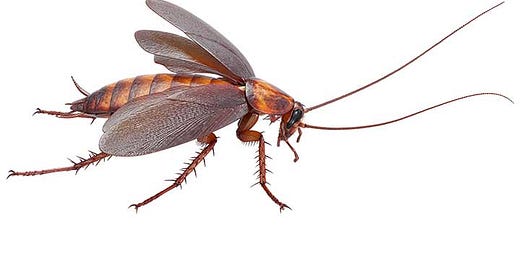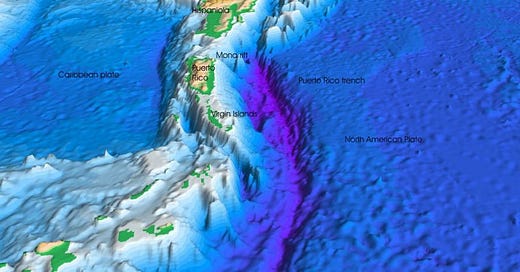
5 Animals Preying on Cockroaches in the Virgin Islands
We consider them pests, but cockroaches are a rich food source in the treeline and have natural predators throughout St. John, St. Croix, St. Thomas, and Puerto Rico.
Cockroaches have succeeded over the centuries because, like most pests, they benefit from the success of humans. They seek shelter in homes, office spaces, and restaurants. But many cockroaches live outdoors in mulch and vegetation, especially in warmer climates. And while they may wander into your home, most are born outside.
Sewers provide insects food, water, and shelter during extreme weather and periods of intense sunlight. You can also find albino cockroaches spread throughout the wild in the U.S. Virgin Islands, British Virgin Islands, and Puerto Rico.
Cockroaches are curious explorers who often crawl up dry drain pipes and lay eggs as they go. When the nymphs hatch, they continue creeping up and out of drains, often ending in dark storage rooms, basements, etc. Messy homes can attract hungry colonies. We consider them pests, but they’re a rich food source in the treeline and have natural predators on St. John, St. Croix, St. Thomas, and Puerto Rico.
Tarantulas
Several tarantula species live in the Virgin Islands and Puerto Rico. The number of tarantula variations and spider species is hard to say, but specimens found in wooded areas are generally small and relatively harmless to humans. Smaller tarantulas on these islands predominantly eat insects, such as katydids, crickets, grasshoppers, caterpillars, beetles, and even baby lizards if the opportunity arises.
Cockroaches are more nutritious than crickets, providing a good energy source for many animals. Tarantulas can rip a cockroach apart in just a few seconds. The hairy spiders don’t have enormous appetites and live in small caves-like holes in the ground. There isn’t a clear scientific consensus on how many tarantula species (or spiders, for that matter) are spread between Puerto Rico and the Virgin Islands.
The biggest and easiest to spot tarantula in the Virgin Islands is cyrtopholis bartholomei. These particular spiders hunt at night and lunge at any small creatures venturing near their den. They use their fang-like chelicerae to inject venom into the prey.
A bite from one can be painful but is not incredibly dangerous to humans. When heavy rains are approaching or destructive hurricanes are imminent, tarantulas climb walls of a home’s exterior or tall trees, searching for higher ground to avoid floodwaters.
Feral Chickens
Because of their varied diet and selective breeding by humans, there are over 500 breeds today. Like the red jungle fowl, chickens and similar birds thrive because they eat almost everything. When you see chickens foraging near the shoreline or in random patches of grass in the Virgin Islands, they may be feeding on worms and insects.
The red jungle fowl can eat foods it finds on the ground as an omnivore, including insects, worms, seeds, berries, and small reptiles. Given the opportunity, chickens will eat cracked chicken eggs and raid the nests of other species. Through decades of European colonization, different species of chickens were bred in captivity and released throughout the Caribbean.
Because of limited genetic data, it’s hard to say how many chicken species live in the Virgin Islands and Puerto Rico. When eating cockroaches, chickens repeatedly smash the insects on pavement or rocks to stun them before swallowing them whole. Chicks just a few days old also take part in foraging for cockroaches and other insects.
Ground Lizards
The Virgin Islands are home to various lizard species, including the Saint Croix ground lizard, found on Protestant Cay, Ruth Cay, Green Cay, and Buck Island.
The most common lizards are ground lizards, tree lizards, and green iguanas. More than one species of ground lizard resides in the Virgin Islands, and their size allows them to take down an impressive variety of insects, including tiny spiders and cockroaches.
Ground lizards forage within fallen leaves and loosely compacted soil, preying on centipedes, moths, spiders, grasshoppers, hermit crabs, sand fleas, and segmented worms. They forage in the daytime and sometimes feast on cockroaches by stirring decaying leaves under the forest canopy.
Centipedes
A centipede will devour any animal it can overpower and kill. Centipedes on St. Croix are common and cockroaches.
It will consume whatever it can catch, with prey items including insects and vertebrates like frogs, snakes, lizards, mice, birds, and bats. No matter the prey type, this species will use its forcipules to inject toxins into its food and then cut into the food to consume it. Centipede bites are notoriously painful for many residents to encounter them.
A few things to note:
Records on centipedes from U.S. Virgin Islands, Haiti, Dominican Republic, Mexico, Puerto Rico, and Honduras are assumed to be accidental introductions or labeling errors. It’s unclear if the centipedes found in the Virgin Islands are native, invasive, or unique species that are undiscovered.
Although not deadly to humans, venom from these centipedes can cause severe swelling, pain, redness, chills, weakness, and fever. An allergic reaction to the biological toxin may also result in death. In 2014, a four-year-old child in Venezuela died after being bitten by a giant centipede hidden inside an open soda can. Researchers at Universidad de Oriente later confirmed the specimen to be S. gigantea.
Geckos (wood slaves)
Sphaerodactylus macrolepus, also known as a ‘wood slave,’ is a house gecko found in Puerto Rico and the Virgin Islands. These tiny geckos --can vary in length and girth-- venture out at night searching for insects. They are nocturnal and can be spotted scurrying for a dark crevice if disturbed in the daytime. They can eat household insects like moths, mosquitos, flies, and cockroaches if they’re quick enough.
Their bellies lay flat on walls and tree trunks as they hunt for smaller insects. Thanks to their specialized limbs, they can also run parallel to the ground -- or directly on the ceiling without falling.
Still, cockroaches are unwanted household pests, and keeping them out of our homes keeps them confined to nature, providing nutrients and an essential cleaning role in surrounding ecosystems.












Seems like there's still a lot of nature to study in the Virgin Islands. Mahogany Birds, hmmm